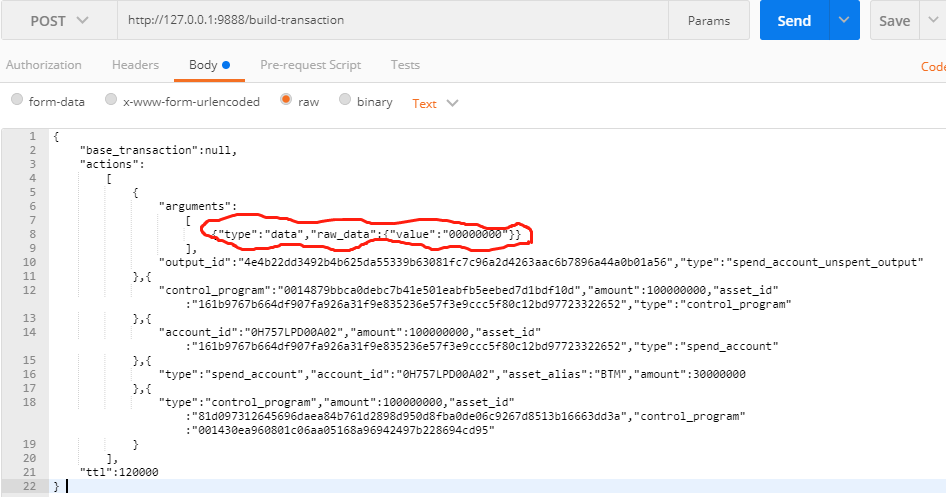溫馨提示×
您好,登錄后才能下訂單哦!
點擊 登錄注冊 即表示同意《億速云用戶服務條款》
您好,登錄后才能下訂單哦!
這篇文章主要介紹“bytom中怎么鎖定合約”,在日常操作中,相信很多人在bytom中怎么鎖定合約問題上存在疑惑,小編查閱了各式資料,整理出簡單好用的操作方法,希望對大家解答”bytom中怎么鎖定合約”的疑惑有所幫助!接下來,請跟著小編一起來學習吧!
模板如下:
contract TradeOffer(assetRequested: Asset,
amountRequested: Amount,
seller: Program,
cancelKey: PublicKey) locks offered {
clause trade() requires payment: amountRequested of assetRequested {
lock payment with seller
unlock offered
}
clause cancel(sellerSig: Signature) {
verify checkTxSig(cancelKey, sellerSig)
unlock offered
}
}

以下是相關代碼片段:
sendHttpPost("{\"account_id\":\"0IJVD7MNG0A02\"}","create-account-receiver","http://127.0.0.1:9888","");

以下是相關代碼片段:
sendHttpPost("{\"account_id\":\"0IJVD7MNG0A02\"}","list-pubkeys","http://127.0.0.1:9888","");

以下是相關代碼片段:
JSONObject param=new JSONObject();
JSONArray agrs=new JSONArray();
//合約的四個參數值
JSONObject assetParam=new JSONObject();
assetParam.put("string","81d097312645696daea84b761d2898d950d8fba0de06c9267d8513b16663dd3a");
agrs.put(assetParam);
JSONObject amountParam=new JSONObject();
amountParam.put("integer",200000000l);
agrs.put(amountParam);
JSONObject programParam=new JSONObject();
programParam.put("string",control_program);
agrs.put(programParam);
JSONObject publicKeyParam=new JSONObject();
publicKeyParam.put("string",pubkey);
agrs.put(publicKeyParam);
param.put("agrs",agrs);
param.put("contract","contract TradeOffer(assetRequested: Asset, amountRequested: Amount, seller: Program, cancelKey: PublicKey) locks offered { clause trade() requires payment: amountRequested of assetRequested { lock payment with seller unlock offered } clause cancel(sellerSig: Signature) { verify checkTxSig(cancelKey, sellerSig) unlock offered } }");
//調用編譯合約
sendHttpPost(param.toString(),"list-pubkeys","http://127.0.0.1:9888","");

以下是相關代碼片段:
param=new JSONObject();
agrs=new JSONArray();
JSONObject spendAccount=new JSONObject();
spendAccount.put("account_id","0H757LPD00A02");
spendAccount.put("amount",9909099090000l);
spendAccount.put("asset_id","161b9767b664df907fa926a31f9e835236e57f3e9ccc5f80c12bd97723322652");
spendAccount.put("type","spend_account");
agrs.put(spendAccount);
JSONObject controlAccount=new JSONObject();
controlAccount.put("control_program",program);
controlAccount.put("amount",9909099090000l);
controlAccount.put("asset_id","161b9767b664df907fa926a31f9e835236e57f3e9ccc5f80c12bd97723322652");
controlAccount.put("type","control_program");
agrs.put(controlAccount);
JSONObject spendAccount2=new JSONObject();
spendAccount2.put("account_id","0H757LPD00A02");
spendAccount2.put("amount",6000000l);
spendAccount2.put("asset_id","ffffffffffffffffffffffffffffffffffffffffffffffffffffffffffffffff");
spendAccount2.put("type","spend_account");
agrs.put(spendAccount2);
param.put("actions",agrs);
param.put("ttl",0);
sendHttpPost(param.toString(),"build-transaction","http://127.0.0.1:9888","");

以下是相關代碼片段:
param=new JSONObject();
param.put("password","xxx");
param.put("transaction",data);
sendHttpPost(param.toString(),"sign-transaction","http://127.0.0.1:9888","");
以下是相關代碼片段:
param=new JSONObject();
param.put("raw_transaction",raw_transaction);
sendHttpPost(param.toString(),"submit-transactions","http://127.0.0.1:9888","");
以下是相關代碼片段:
param=new JSONObject();
param.put("id",outputid);
param.put("smart_contract",true);
sendHttpPost(param.toString(),"list-unspent-outputs","http://127.0.0.1:9888","");
以下是相關代碼片段:
param=new JSONObject();
param.put("program",program);
sendHttpPost(param.toString(),"decode-program","http://127.0.0.1:9888","");需要注意的是decode出來的為值是逆序的(后續會有文章詳細介紹)
取消合約的構造參數如下: 
spendAccountUnspentOutput = arguments: [{
type: 'raw_tx_signature',
// 生成合約第二步的pubkeylist 詳情
raw_data: {
derivation_path: pubkeylist.pubkey_infos[0].derivation_path,
xpub: pubkeylist.root_xpub
}
}, {
type: 'data',
raw_data: {
// 參數偏移量 在一個合約里是固定的
value: '13000000'
}
}],
output_id: output_id,
type: 'spend_account_unspent_output'
}
const controlAction = {
type: 'control_program',
amount: 100000000,
asset_id: asset_id,
control_program:control_program
}
const gasAction = {
type: 'spend_account',
account_id:account_id,
asset_alias: 'BTM',
amount: 50000000
}執行合約的參數構造如下: 
const spendAccountUnspentOutput = {
arguments: [{
type: 'data',
raw_data: {
// 00000000 指的是第一個 clause,表示直接執行,無需跳轉
value: '00000000'
}
}],
output_id: output_id,
type: 'spend_account_unspent_output'
}
// 合約執行提供的資產
const issueControlAction = {
control_program: control_program,
amount: 100000000,
asset_id: asset_id,
type: 'control_program'
}
// 合約執行提供的資產
const issueSpendAction = {
account_id: account_id,
amount: 100000000,
asset_id: asset_id,
type: 'spend_account'
}
// 礦工費
const gasAction = {
type: 'spend_account',
account_id: account_id,
asset_alias: 'BTM',
amount: 50000000
}
// 合約執行獲得資產對象
const controlAction = {
type: 'control_program',
amount: 100000000,
asset_id: asset_id,
control_program: compileData.control_program
}build 操作其實就是指定輸入輸出的過程,詳情請查看 官方build文檔 和 官方api文檔
調用比原基于okhttp接口javautil 如下:
public static String sendHttpPost(String bodyStr,String method,String bytomApiserverUrl,String bytomApiserverToken) throws IOException {
OkHttpClient client = new OkHttpClient();
MediaType mediaType = MediaType.parse("application/json");
RequestBody body = RequestBody.create(mediaType, bodyStr);
Request request = new Request.Builder()
.url(bytomApiserverUrl+"/"+method)
.post(body)
.addHeader("cache-control", "no-cache")
.addHeader("Connection", "close")
.build();
if (bytomApiserverUrl==null || bytomApiserverUrl.contains("127.0.0.1") || bytomApiserverUrl.contains("localhost")){
}else {
byte[] encodedAuth = Base64.encodeBase64(bytomApiserverToken.getBytes(Charset.forName("US-ASCII")));
String authHeader = "Basic " + new String(encodedAuth);
request = new Request.Builder()
.url(bytomApiserverUrl+"/"+method)
.post(body)
.addHeader("authorization", authHeader)
.addHeader("cache-control", "no-cache")
.addHeader("Connection", "close")
.build();
}
Response response = client.newCall(request).execute();
return response.body().string();
}到此,關于“bytom中怎么鎖定合約”的學習就結束了,希望能夠解決大家的疑惑。理論與實踐的搭配能更好的幫助大家學習,快去試試吧!若想繼續學習更多相關知識,請繼續關注億速云網站,小編會繼續努力為大家帶來更多實用的文章!
免責聲明:本站發布的內容(圖片、視頻和文字)以原創、轉載和分享為主,文章觀點不代表本網站立場,如果涉及侵權請聯系站長郵箱:is@yisu.com進行舉報,并提供相關證據,一經查實,將立刻刪除涉嫌侵權內容。